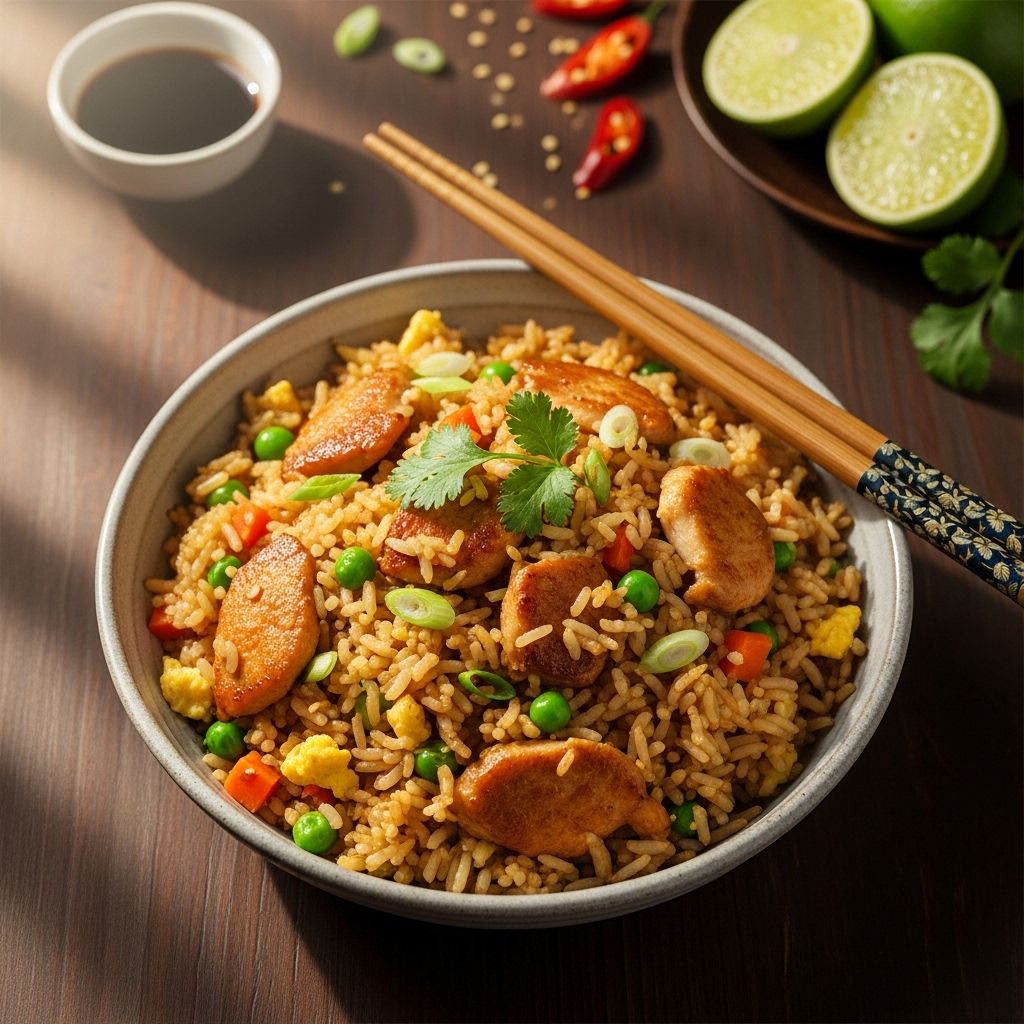Chicken Fried Rice Recipe: 10 Quick Steps For Authentic Flavor
Master the art of creating restaurant-quality chicken fried rice in your own kitchen

Image: HearthJunction Design Team
Homemade Chinese Chicken Fried Rice: An Easy Weeknight Delight
Chinese chicken fried rice is one of those versatile dishes that combines convenience, flavor, and comfort in a single bowl. Whether you’re looking to repurpose leftover rice and chicken or craving a homemade alternative to takeout, this classic dish delivers satisfaction with minimal effort. Our recipe for Chinese Chicken Fried Rice II brings authentic flavors right to your kitchen with ingredients you likely already have on hand.
Fried rice has been a staple in Chinese cuisine for centuries, originally created as a clever way to transform leftover rice into a new meal. Today, it’s beloved worldwide for its adaptability and simplicity. The beauty of this dish lies in its balance—tender chicken, fluffy rice with slightly crispy edges, and vegetables all bound together with savory soy sauce and aromatic seasonings.
Why You’ll Love This Recipe
There’s something incredibly satisfying about creating restaurant-quality fried rice at home. This recipe strikes the perfect balance between simplicity and flavor, making it ideal for busy weeknights when you need a quick, satisfying meal. Unlike takeout versions that can be greasy or bland, this homemade version allows you to control the ingredients and customize the flavors to your preference.
The technique used in this recipe creates distinct layers of flavor—starting with a delicate egg base, followed by sautéed onions that provide sweetness, and finished with the perfect marriage of tender chicken and rice. The result is a dish with varied textures and complementary flavors in every bite.
Essential Ingredients
The beauty of chicken fried rice lies in its simplicity and flexibility. While our recipe specifies certain ingredients, feel free to adapt based on what you have available in your pantry and refrigerator. The key to success is preparation—having all ingredients ready before you begin cooking ensures a smooth process and perfectly cooked results.
The Foundation
At the heart of any good fried rice recipe is, of course, the rice itself. Here’s what you’ll need for this classic version:
- Rice: 2 cups of cooked white rice, cold (day-old rice works best)
- Protein: 1 cup of cooked, chopped chicken meat
- Egg: 1 large egg (for creating those delicious egg ribbons)
- Aromatics: 1 medium onion, chopped
Seasonings and Oils
The right combination of seasonings transforms simple ingredients into a flavorful dish:
- Soy Sauce: 2 tablespoons (provides the signature umami flavor)
- Black Pepper: 1 teaspoon ground (or to taste)
- Butter: 1 tablespoon (adds richness)
- Vegetable Oil: 1 tablespoon (for stir-frying)
- Water: 1 tablespoon (for the egg mixture)
Equipment Needed
One of the advantages of making fried rice at home is that it requires minimal specialized equipment. Here’s what you’ll need to prepare this dish:
- A large skillet or wok (a well-seasoned cast iron skillet works wonderfully)
- A wooden spoon or heat-resistant spatula for stirring
- A small bowl for beating the egg
- A cutting board and knife for preparation
- Measuring spoons and cups
Step-by-Step Instructions
The key to perfect fried rice is quick cooking over high heat, which means preparation is crucial. Having all your ingredients measured, chopped, and ready to go before you start cooking will ensure success.
Preparation
Before you begin the cooking process, take these important preparation steps:
- Ensure your rice is cold—ideally day-old rice from the refrigerator. Fresh, warm rice tends to clump and become mushy when stir-fried.
- Chop your onion into uniform pieces to ensure even cooking.
- Make sure your chicken is fully cooked and chopped into bite-sized pieces.
- Beat the egg and water together in a small bowl until well combined.
- Measure out your soy sauce and have pepper ready for seasoning.
Cooking Process
Now that everything is prepared, you’re ready to cook your Chinese Chicken Fried Rice II:
- Melt butter in your large skillet or wok over medium-low heat.
- Add the beaten egg and water mixture to the skillet, allowing it to cook undisturbed for 1-2 minutes until set but not browned.
- Remove the cooked egg from the skillet and cut it into thin shreds using a knife or spatula. Set these egg shreds aside for later.
- In the same skillet, heat the vegetable oil.
- Add the chopped onion and stir-fry until soft and translucent, about 3 minutes.
- Add the cold rice to the skillet, breaking up any clumps with your spatula or spoon.
- Stir in the chopped chicken meat, ensuring it’s distributed evenly throughout the rice.
- Pour the soy sauce over the mixture and season with black pepper.
- Cook and stir the mixture for approximately 5 minutes, allowing the rice to heat through and slightly crisp.
- Finally, gently fold in the shredded egg you set aside earlier, distributing it throughout the dish.
Serving Suggestions
Chinese Chicken Fried Rice II is versatile enough to be served as either a main dish or a side. Here are some suggestions for serving:
- Serve hot as a complete meal on its own—it contains protein, carbohydrates, and vegetables in one dish.
- Pair with stir-fried vegetables such as broccoli or bok choy for added nutrition.
- Serve alongside other Chinese favorites like sweet and sour chicken or beef with broccoli for a homemade feast.
- Garnish with additional chopped green onions or a sprinkle of sesame seeds for extra flavor and visual appeal.
Variations and Customizations
One of the greatest advantages of making fried rice at home is the ability to customize it to your preferences. Here are some popular variations you might want to try:
Vegetable Additions
While our base recipe keeps it simple with onions, many traditional fried rice recipes incorporate additional vegetables. Consider adding:
- Diced carrots and peas (traditional additions that add color and nutrition)
- Bell peppers (red, green, or yellow for color and crunch)
- Bean sprouts (for added texture)
- Sliced mushrooms (for earthy flavor)
- Green onions (sprinkle on top for freshness)
Protein Variations
Chicken is just one option for protein in your fried rice. Feel free to substitute with:
- Diced ham or Chinese barbecue pork
- Shrimp or other seafood
- Tofu (for a vegetarian option)
- Ground beef or pork
- A combination of proteins for an extra-special version
Flavor Enhancements
To elevate the flavor profile even further, consider these additions:
- A dash of oyster sauce for depth
- Chinese five-spice powder for aromatic complexity
- Sesame oil drizzled at the end for nutty flavor
- Sriracha or chili oil for heat
- Minced garlic or ginger added with the onions
Tips for Perfect Fried Rice
Creating restaurant-quality fried rice at home is achievable with these professional tips:
- Use cold rice: Freshly cooked rice contains too much moisture and will become mushy when stir-fried. Day-old refrigerated rice yields the best texture.
- Cook over high heat: A hot wok or skillet ensures that ingredients cook quickly without steaming, preserving their texture and flavor.
- Don’t overcrowd the pan: If making a large batch, consider cooking in portions to maintain proper temperature and prevent steaming.
- Keep ingredients moving: Constant stirring prevents burning and ensures even cooking.
- Season carefully: Start with less soy sauce than you think you need—you can always add more, but you can’t take it away.
Storage and Reheating
Properly stored, Chinese Chicken Fried Rice II makes excellent leftovers:
- Refrigeration: Store cooled leftover fried rice in an airtight container in the refrigerator for up to 3-4 days.
- Freezing: For longer storage, fried rice can be frozen in airtight containers or freezer bags for up to 2 months.
- Reheating: The best way to reheat fried rice is in a skillet with a small amount of oil to restore its texture. Microwave reheating works in a pinch—just add a sprinkle of water and cover to steam slightly.
Nutritional Information
While specific nutritional values vary based on the exact ingredients and portions used, Chinese Chicken Fried Rice II generally provides a balanced meal with protein, carbohydrates, and some vegetables. To make it even more nutritious, consider using brown rice instead of white and increasing the proportion of vegetables.
Frequently Asked Questions (FAQs)
Q: Why is my fried rice mushy instead of fluffy?
A: The most common reason for mushy fried rice is using freshly cooked rice that’s still warm and moist. For best results, use day-old refrigerated rice that has had time to dry out slightly. Also, avoid overcrowding the pan, which can cause ingredients to steam rather than fry.
Q: Can I make this dish vegetarian?
A: Absolutely! Simply omit the chicken and add extra vegetables like carrots, peas, bell peppers, and mushrooms. For protein, consider adding tofu or edamame. Just ensure the tofu is well-pressed and preferably pre-fried for the best texture in your fried rice.
Q: What can I substitute for soy sauce if I have dietary restrictions?
A: For a gluten-free option, use tamari or certified gluten-free soy sauce. If you’re watching sodium intake, look for low-sodium soy sauce varieties. Coconut aminos provides a soy-free alternative with a slightly sweeter flavor profile that works well in fried rice.
Q: How can I add more flavor to my fried rice?
A: Consider adding aromatic ingredients like minced garlic or ginger at the beginning of cooking. A dash of sesame oil at the end adds wonderful nutty flavor. Chinese five-spice powder, as mentioned in variations, adds complexity. Don’t forget umami boosters like oyster sauce or a sprinkle of MSG if you’re not sensitive to it.
Q: Can I use other grains instead of rice?
A: While traditional fried rice uses white rice, you can experiment with other grains. Brown rice works well but may require slightly more oil and cooking time. Quinoa, cauliflower rice, or even farro can be used for interesting variations, though the texture and cooking technique may need to be adjusted.
With these tips, variations, and step-by-step instructions, you’re well-equipped to create delicious Chinese Chicken Fried Rice II at home. This versatile dish allows endless customization while maintaining its comforting, satisfying essence. Whether you’re repurposing leftovers or creating a special meal from scratch, homemade fried rice is sure to become a regular in your cooking rotation.
References
- https://www.allrecipes.com/recipe/16954/chinese-chicken-fried-rice-ii/
- https://www.allrecipes.com/recipe/17161/chinese-chicken-fried-rice-i/
- https://www.allrecipes.com/easy-chicken-fried-rice-recipe-8644579
- https://www.allrecipes.com/recipe/79543/fried-rice-restaurant-style/
- https://www.simplyrecipes.com/recipes/chicken_fried_rice/
Read full bio of Srija Burman












